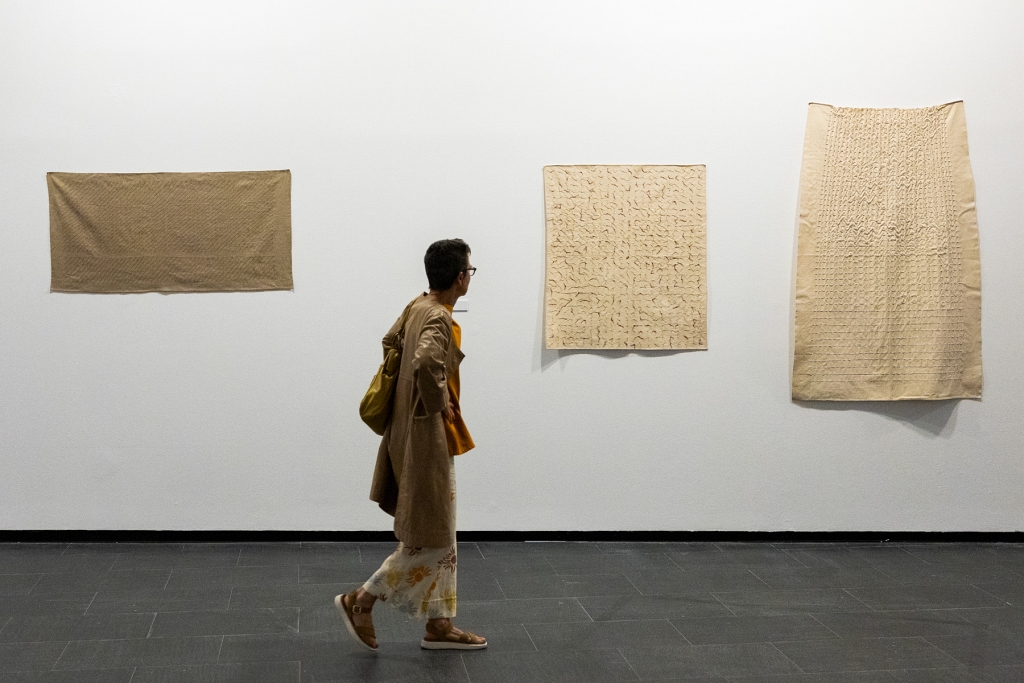- CA2M MUSEUM
- exhibitions
- BY HAND 1979–1980. SUSANA SOLANO
BY HAND 1979–1980. SUSANA SOLANO

The sculptor Susana Solano held her first solo exhibition at the Fundació Joan Miró in Barcelona from 2–20 April 1980. Given the title Escultures i dibuixos (Sculptures and Drawings), the exhibition occupied the space reserved for younger artists, which today would be classed as an artist-run space, with a faster turnover than the more leisurely intervals typical of an institutional framework. That space, Espai 10, made it possible to accommodate a large number of projects throughout the year, and at the time, it was undoubtedly one of the most innovative of its kind in Spain.
The exhibition consisted of a series of wooden pieces defined by a singular way of collecting light in volumes by the effect of their grain. To these sculptures of categorical yet organic forms – with ergonomic and furniture-like references to the human body – Susana Solano added oddly bulky, puckered canvases of a monumental size. The folds and bulges of fabric were either the result of the way the fabric emerged from the wall when it was stitched and threaded, or the effect given to the fabric when it was hung from the ceiling or cut into a particular pattern and framed. The interventions are minimal, with tonal variations and texture given by curls, wrinkles or pleats. However they generated a rich haptic experience through a stitching technique that revelled in repetition and the possibility of interruption or variation.
Like a missing link between the textile sculpture of Aurèlia Muñoz in the 1960s and the tapestries of Teresa Lanceta in the late 1980s, but also between the subversive stitching of the feminist tradition and the expressive architectural physicality of Ángela de la Cruz’s painting, those 12 canvases heralded the concentration – both introspective and theatrical at the same time – of the minimalist structures that would characterise Susana Solano’s work in metal during the 1980s. They constitute the genealogical pattern, the literal thread of history, for the formation of the so-called New Spanish Sculpture, which paralleled the coetaneous development of New British Sculpture, at a moment of singular synchronicity between our art and the international context.
The set of textile pieces shown in that debut solo exhibition, which have remained out of the spotlight since those 18 days when they were on public display, are the same ones that are shown in their entirety on this occasion. On the one hand, these works allow us to continue to explore the central theme of this year’s exhibition programme: what has happened to sculpture, to the objects produced by artists, over the last few decades in our country. And on the other hand, we would also like to celebrate their addition to the collection of the CA2M Museum thanks to the artist’s gracious generosity. These pieces both enrich our institution’s collection of contemporary textile art and allow us to add new emphasis to our commitment to retrieving the forgotten legacy of women artists in Spain and making it available to the public. Hence the title of this exhibition: thread is used for sewing, but it is also the substance of the cloth and what gives continuity to a discourse. In biology, it is the linear sequence of nucleic acids, the makings of DNA.
Susana Solano (Barcelona, 1946), in addition to having her work form a part of the most important public and private collections in the country, would, by the mid-1980s become the most internationally renowned Spanish artist, with the most outstanding trajectory since the classic male figures of the historical avant-garde movements. She was awarded the Spanish National Plastic Arts Award in 1988 and took part in the 1987 and 1992 editions of Documenta in Kassel, and the 1988 and 1993 editions of the Venice Bienniale. Since 1987, her work has been on permanent public display in the city of Münster, the result of her participation that year in Sculpture Projects Münster, the most important event of its kind in the world, where her work coexists in the public space with others by Dan Graham, Jenny Holtzer, Thomas Schütte, Susan Phillipzs and Bruce Nauman.